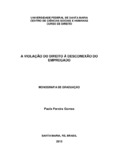| dc.contributor.advisor | Oliveira, Rafael Santos de | |
| dc.contributor.advisor | Nedel, Nathalie Kuczura | |
| dc.creator | Gomes, Paola Pereira | |
| dc.date.accessioned | 2017-05-05T02:13:16Z | |
| dc.date.available | 2017-05-05T02:13:16Z | |
| dc.date.issued | 2015-12-01 | |
| dc.date.submitted | 2015 | |
| dc.identifier.uri | http://repositorio.ufsm.br/handle/1/2822 | |
| dc.description | Trabalho de conclusão de curso (graduação) - Universidade Federal de Santa Maria, Centro de Ciências Sociais e Humanas, Curso de Direito, RS, 2016 | por |
| dc.description.abstract | Work relations have been substantially changing along the years. A large part of these changes is due to the advance of information and communication new technologies, which enable an infinity of different ways to hire. In this regard, it is necessary that labor law follows these advances, in order to regulate the possible conflicts derived from work relations. Furthermore, these changes normally generate some reflections in the employee’s working time, both positive and negative. One of these reflections is the violation of the employee’s right to disconnect. Thereby, this work aims to analyze the implications of the excessive use of information and communication new technologies in the work environment. In this situation, it is inquired how the Brazilian Labor Courts have been facing the right todisconnect, and if their decisions are the most adequate to the employee’s protection? The approach method used is the dialectic, analyzing different understandings of the courts about the violation of the employee’s right to disconnect. Therewith, it is intended to verify if there is uniformity in the judgement organs about the recognition of the violation to the disconnection right, as well as to verify the fundamentals that sustain these decisions. Moreover, the work is led by the comparative and monographic methods of procedure. It was concluded that there is a great divergency between the Regional Labor Courts of 4th and 5th Regions, and that, although Superior Labor Court is inclined to recognize the violation of the right to disconnect, there is still no uniformity among the court sections. | eng |
| dc.language | por | por |
| dc.publisher | Universidade Federal de Santa Maria | por |
| dc.rights | Acesso Aberto | por |
| dc.subject | Descanso | por |
| dc.subject | Direito à desconexão | por |
| dc.subject | Direito do trabalho | por |
| dc.subject | Jornada de trabalho | por |
| dc.subject | Tecnologias de Informação e Comunicação (TICs) | por |
| dc.subject | Rest | eng |
| dc.subject | Right to disconnect | eng |
| dc.subject | Labor law | eng |
| dc.subject | Information and communication technologies | eng |
| dc.subject | Working hours | eng |
| dc.title | A violação do direito à desconexão do empregado | por |
| dc.title.alternative | The violation of the employee’s right to disconnect | eng |
| dc.type | Trabalho de Conclusão de Curso de Graduação | por |
| dc.degree.local | Santa Maria, RS, Brasil | por |
| dc.degree.graduation | Direito | por |
| dc.description.resumo | As relações de trabalho vêm alterando-se substancialmente ao longo dos anos. Grande parte dessas mudanças é decorrente do avanço das novas tecnologias de informação e comunicação, as quais possibilitam uma infinidade de formas de contratar. Nesse sentido, é necessário que o direito do trabalho acompanhe esses avanços, a fim de regular os possíveis conflitos oriundos das relações de trabalho. Ademais, essas alterações, normalmente, geram reflexos na jornada de trabalho do empregado, sejam eles positivos ou negativos. Um desses reflexos é a violação do direito à desconexão do empregado. Dessa forma, o presente trabalho visa analisar as implicações do excesso da utilização das novas tecnologias de informação e comunicação no ambiente de trabalho. Diante dessa situação, cabe perquirir como os Tribunais Trabalhistas Brasileiros vêm enfrentando o direito à desconexão, e se os posicionamentos são os mais adequados à proteção do trabalhador? Para tanto, utiliza-se o método de abordagem dialético, eis que são analisadas as diferentes posições dos tribunais frente às violações do direito à desconexão do empregado. Com isso, pretende-se verificar se existe uma uniformidade nos órgãos julgadores quanto ao reconhecimento ou não da violação ao direito à desconexão, bem como os fundamentos que embasam as decisões. Ademais, o trabalho é conduzido pelos métodos de procedimento monográfico e comparativo. Concluiu-se que há grande divergência entre os Tribunais Regionais do Trabalho da 4ª e 5ª Regiões, e, que, embora o Tribunal Superior do Trabalho esteja propenso a reconhecer a violação ao direito à desconexão, não existe uma uniformidade entre as Turmas. | por |
| dc.publisher.unidade | Centro de Ciências Sociais e Humanas | por |


